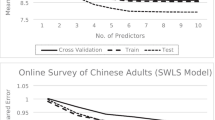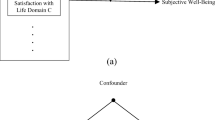Abstract
The purpose of this study was to (1) construct an index to indicate the strength of a tendency to upgrade importance of life domains with lower have–want discrepancy and downgrade importance of life domains with larger have–want discrepancy for an individual (termed shifting tendency) and (2) use this index to test if shifting tendency has a positive correlation with global life satisfaction. The dataset was gain from Wu and Yao, 2006, Social Indicators Research, 79, 485–502), in which 332 undergraduate students at National Taiwan University participated in the survey. The mean age was 19.80 years (SD = 1.98). They completed a quality of life questionnaire, which contains 12 life domains. Satisfaction, importance and perceived have–want discrepancy were measured for 12 different life domains. Global life satisfaction was measured as well. Results showed that shifting tendency had a positive and significant correlation with average domain satisfaction and global life satisfaction. In addition, shifting tendency and have–want discrepancy had unique effects in predicting average domain satisfaction and global life satisfaction, suggesting that shifting tendency itself can contribute to a better QOL. The role of shifting tendency on QOL was discussed.
Similar content being viewed by others
References
Calman, K. C. (1984). Quality of life of cancer patients – A hypothesis. Journal of Medical Ethics, 10, 124–127.
Campbell, A., Converse, P. E., & Rogers, W. L. (1976). The quality of American life: Perceptions, evaluations, and satisfaction. New York: Russell Sage Foundation.
Cohen, E. H. (2000). A facet theory approach to examining overall and life facetsatisfaction relationships. Social Indicators Research, 51, 223–237.
Crocker, J., Brook, A. T., Niiya, Y., & Villacorta, M. (2006). The pursuit of self-esteem: Contingencies of self-worth and self-regulation. Journal of Personality, 74, 1749–1772.
Crocker, J., Karpinski, A., Quinn, D. M., & Chase, S. (2003). When grades determine self-worth: Consequences of contingent self-worth for male and female engineering and psychology majors. Journal of Personality and Social Psychology, 85, 507–516.
Cummins, R. A. (1997). Comprehensive quality of life scale – Adult: Manual. Australia: Deakin University.
Cummins, R. A., & Nistico, H. (2002) Maintaining life satisfaction: The role of positive cognitive bias. Journal of Happiness Studies, 3, 37–69.
Diener, E., Emmons, R. A., Larsen, R. J., & Griffin, S. (1985). The Satisfaction with life scale. Journal of Personality Assessment, 49, 71–75.
Ferrans, C., & Powers, M. (1985). Quality of life index: Development and psychometric properties. Advances in Nursing Science, 8, 15–24.
Frisch, M. B. (1992). Use of the quality of life inventory in problem assessment, treatment planning for cognitive therapy of depression. In A. Freeman & F. M. Dattlio (Eds.), Comprehensive casebook of cognitive therapy (pp. 27–52). New York: Plenum Press.
Hardy, L., & Moriarty, T. (2006). Shaping self-concept: The elusive importance effect. Journal of Personality, 74, 377–402.
Jansen, S. J., Stiggelbout, A. M., Nooij, M. A., Noordijk, E. M., & Kievit, J. (2000). Response shift in quality of life measurement in early-stage breast cancer patients undergoing radiotherapy. Quality of Life Research, 9, 603–615.
Locke, E. A. (1969). What is job satisfaction? Organizational Behavior and Human Performance, 4, 309–336.
Locke, E. A. (1976). The nature and causes of job satisfaction. In M. D. Dunnette (Ed.), Handbook of industrial and organizational psychology (pp. 1297–1343). Chicago: Rand McNally.
Locke, E. A., & Latham, G. P. (1990). A theory of goal setting and task performance. Englewood Cliffs, NJ: Prentice Hall.
McFarlin, D. B., Coster, E. A., Rice, R. W., & Coopper-Alison, T. (1995). Facet importance and job satisfaction: Another look at the range of affect hypothesis. Basic and Applied Social Psychology, 16, 489–502.
McFarlin, D. B., & Rice, R. W. (1992). The role of facet importance as a moderator in job satisfaction processes. Journal of Organizational Behavior, 13, 41–54.
Michalos, A. C. (1985). Multiple discrepancy theory (MDT). Social Indicators Research, 16, 347–413.
Mobley, W. H., & Locke, E. A. (1970). The relationship of value importance to satisfaction. Organisational Behavior and Human Performance, 5, 463–483.
Moskowitz, J. T., Folkman, S., Collette, L., & Vittinghoff, E. (1996). Coping and mood during AIDS-related caregiving and bereavement. Annals of Behavioral Medicine, 18, 49–57.
Pelham, B. W., & Swann, W. B. (1989). From self-conceptions to self-worth: On the sources and. structure of global self-esteem. Journal of Personality and Social Psychology, 57, 672–680.
Pavot, W., & Diener, E. (1993). Review of the satisfaction with life scale. Psychological Assessment, 5, 164–172.
Rapkin, B. D., & Shwartz C. E. (2004). Toward a theoretical model of quality of life appraisal: Implications of findings from studies of response shift. Health and Quality of Life Outcomes, 2, 14.
Rapkin, B. D. (2000). Personal goals and response shifts: Understanding the impact of illness and events on the quality of life of people living with AIDS. In C.E. Schwartz, & M. A. G. Sprangers (Eds.), Adaptation to changing health: Response shift in quality of life research. Washington D.C.: American Psychological Association.
Rice, R. W., Gentile, D. A., & McFarlin, D. B. (1991a). Facet importance and job satisfaction. Journal of Applied Psychology, 76, 31–39.
Rice, R. W., Markus, K., Moyer, R. P., & McFarlin, D. B. (1991b). Facet importance and job satisfaction: Two experimental tests of Locke's range of affect hypothesis. Journal of Applied Social Psychology, 21, 1977-1987.
Schulz, W. (1995). Multiple-discrepancies theory versus resource theory. Social Indicators Research, 34, 153–169.
Schwartz, C. E., Coulthard-Morris, L., Cole, B., & Vollmer, T. (1997). The quality-of-life effects of Interferon-Beta-1b in multiple sclerosis: An Extended Q-TWiST analysis. Archives of Neurology, 54, 1475–1480.
Shin, D. C., & Johnson, D. M. (1978). Avowed happiness as an overall assessment of the quality of life. Social Indicators Research, 5, 475–492.
Sprangers, M. A. G., & Schwartz, C. E. (1999). Integrating response shift into health-related quality of life research: A theoretical model. Social Science and Medicine, 48, 1507–1515.
The WHOQOL Group (1998). The World Health Organization Quality of Life Assessment (WHOQOL): Development and general psychometric properties. Social Science and Medicine, 46, 1569–1585.
The WHOQOL-Taiwan Group (1999). The User’s manual of the development of the WHOQOL-100 Taiwan version (1st ed.) Taipei: National Taiwan University.
Tunali, B., & Power, T. G. (1993). Creating satisfaction: A psychological perspective on stress and coping in families of handicapped children. Journal of child psychology and psychiatry, 34, 945–957.
Vermunt, R., Spaans, E., & Zorge, F. (1989). Satisfaction, happiness and well-being of Dutch students. Social Indicators Research, 21, 1–33.
Welham, J., Haire, M., Mercer, D., & Stedman T. (2001). A gap approach to exploring quality of life in mental health. Quality of Life Research, 10, 421–429.
Wrosch, C., & Heckhausen, J. (1999). Control processes before and after passing a developmental deadline: Activation and deactivation of intimate relationship goals. Journal of Personality and Social Psychology, 77, 415–427.
Wrosch, C., & Scheier, M. F. (2003). Personality and quality of life: The importance of optimism and goal adjustment. Quality of Life Research, 12, 59–72.
Wrosch, C., Scheier, M. F., Miller, G. E., Schulz, R., & Carver, C. S. (2003). Adaptive self-regulation of unattainable goals: Goal disengagement, goal re-engagement, and subjective well-being. Personality and Social Psychology Bulletin, 29, 1494–1508.
Wu, C. H., & Yao, G. (2006a). Do we need to weight item satisfaction by item importance? A perspective from Locke’s range-of-affect hypothesis. Social Indicators Research, 79, 485–502.
Wu, C. H., & Yao, G. (2006b). Analysis of factorial invariance across gender in the Taiwan version of the Satisfaction with Life Scale. Personality and Individual Differences, 40, 1259–1268.
Wu, C. H., & Yao, G. (2007). Importance has been considered in satisfaction evaluation: An experimental examination of Locke’s range-of-affect hypothesis. Social Indicators Research, 81, 521–541.
Author information
Authors and Affiliations
Corresponding author
Rights and permissions
About this article
Cite this article
Wu, CH. Enhancing quality of life by shifting importance perception among life domains. J Happiness Stud 10, 37–47 (2009). https://doi.org/10.1007/s10902-007-9060-7
Received:
Accepted:
Published:
Issue Date:
DOI: https://doi.org/10.1007/s10902-007-9060-7




